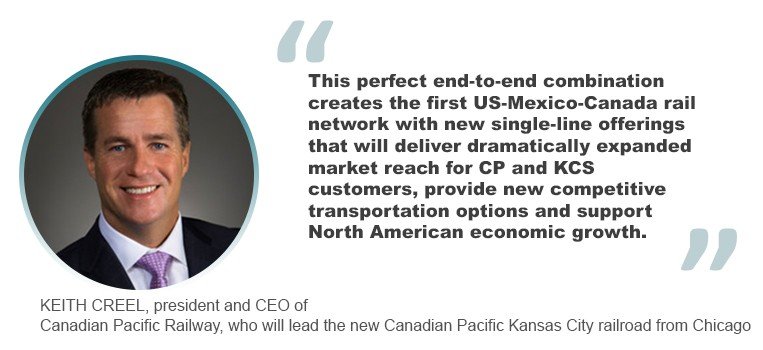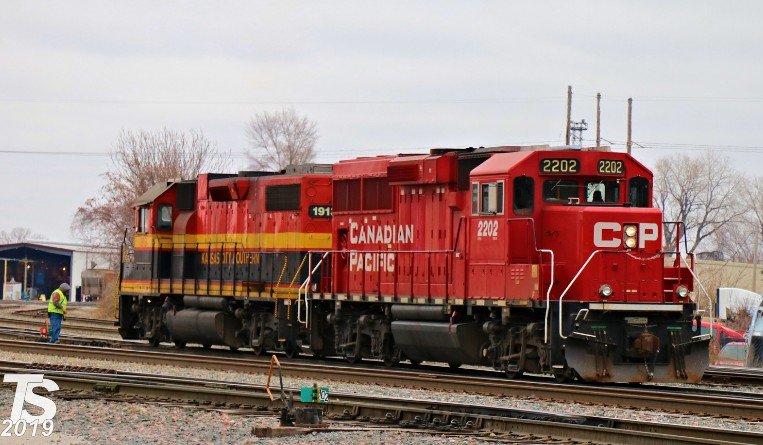In the aftermath of their tug-of-war over Kansas City Southern (KCS), Canadian Class I railroads Canadian National (CN) and Canadian Pacific (CP) have turned their gaze to the future and laid out plans for the coming years.
The takeover battle ended on September 15, when CN announced it was abandoning the pursuit after the board of directors of KCS had deemed CP’s US$31 billion bid “superior”. CN had offered US$33.6 billion, which initially swayed KCS’s directors, but after the U.S. Surface Transportation Board (STB) rejected CN’s application to use a voting trust for the acquisition, the directors concluded that a marriage with CN might not obtain regulatory approval and switched their attention back to CP, which had been the initial suitor.
With the takeover battle behind them, CP and KCS top brass trained their sights on the impending marriage and its opportunities. The amalgamated Class I operator will be called Canadian Pacific Kansas City (CPKC) and will be led by current CP president and CEO, the Chicago-based Keith Creel, as CEO. It will be the first rail carrier with a network spanning all three USMCA nations – the United States, Mexico and Canada – with 20,000 miles of track, nearly 20,000 employees and revenues of around US$8.7 billion (based on 2020 results).
The pair expect annualized synergies of about US$1 billion over three years.
In a joint call with investors, Creel and Pat Ottensmeyer, his counterpart at KCS, who will head the US business of the amalgamated railroad, extolled the benefits and opportunities of the merger.
“This perfect end-to-end combination creates the first US-Mexico-Canada rail network with new single-line offerings that will deliver dramatically expanded market reach for CP and KCS customers, provide new competitive transportation options and support North American economic growth,” declared Creel.
“We believe that this combination – and the creation of this network – will help drive that growth and attract manufacturing and investments back to all three countries in North America,” echoed Ottensmeyer. “This creates truck-competitive options and single-line service options to leverage this network and provide significant environmental advantages and reduced carbon emissions by converting truck traffic into the railroad.”
The pair see a number of areas where the new railroad can make a difference. With access to Pacific, Atlantic and Gulf ports, it offers international shippers a range of access points. It can link automotive manufacturing areas with distribution centers across the USMCA area and offer new routes for energy, chemical and merchandise shippers. In addition, it can compete with trucks across the region with intermodal service targeting high-value parts, perishables and expedited markets, they stressed.
With regard to international shipping, Ottensmeyer highlighted CPKC’s reach to the ports of Vancouver, St John’s and Lazaro, noting that the Mexican port could serve as an alternative to the congested ports in southern California.
John Brooks, chief marketing officer of CP, added that CPKC will be able to replicate what CP has done with Maersk in western Canada, referring to an inland transload and distribution facility that the railroad operates exclusively for the ocean line, shuttling containers from the port of Vancouver to the facility for transloading onto 53-ft trailers to avoid congestion at the port.
Ottensmeyer and Creel emphasized that the amalgamation of the two carriers would not affect competition and reiterated their earlier assurances that they were committed to keeping all existing rail gateways open on commercially reasonable terms.
CP intends to submit its revised merger application to the STB in mid-October and expects the authority’s review to be completed in the second half of next year. After this they envisage the full integration to take three years.
Having turned its back on the KCS battle, CN management quickly pivoted to forward-looking mode. Within days of the abandonment of the KCS pursuit, it presented a strategic and financial value creation plan called “full speed ahead – redefining railroading” that targets improved operating results and reduced spending as well as advances in sustainability.
The plan calls for the operating ratio to be brought to 57%, while operating income should improve by 20% next year. At the same time, management wants to reduce the cost structure, partly by streamlining management, and cut capital spending to 17% of revenues in 2022. Another objective is a 43% reduction in carbon emissions by 2030.
“We spent the last several years making strategic and important customer-centric investments in our network, technology, sustainability and people. These investments have allowed us to deliver high-quality returns to our customers and position us well to drive more sustainable returns to shareholders over the long term. I am confident the CN’s senior management, a team of world-class railroaders who are focused on redefining the rail industry, have the skills and determination to lead the company into this exciting next phase,” said Robert Pace, chair of CNs’ board of directors.
His comment, and the presentation of the plan, came in response to criticism from the company’s largest shareholder, TCI Fund Management. It had accused the board of wasting time and resources on the pursuit of the KCS merger, calling it “an ill-conceived pursuit of an unattainable target”. TCI nominated four new candidates for the management board and called for a shareholder meeting to discuss the removal of CEO Jean-Jacques Ruest and other senior board members.




